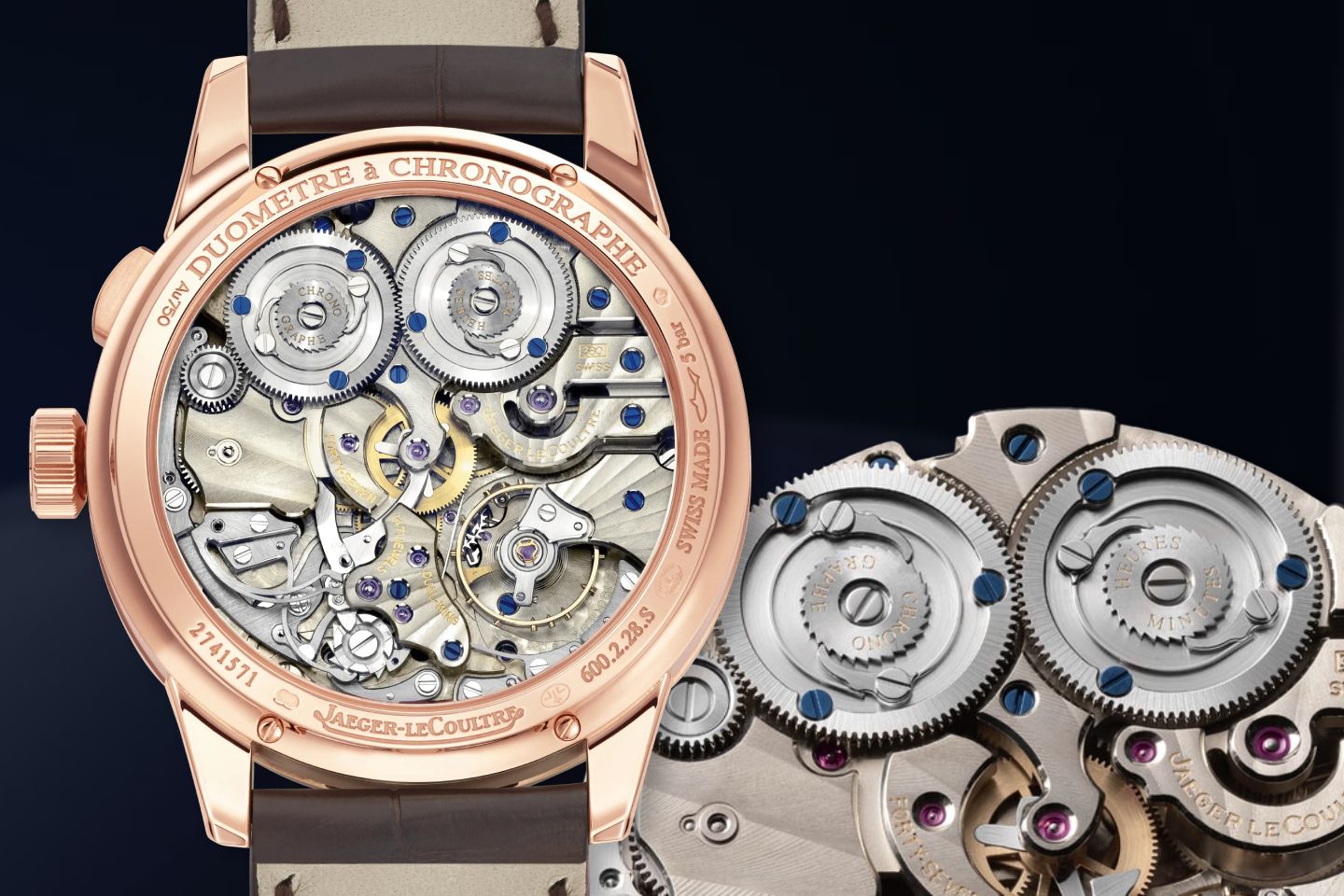One Watch Two Movements: Jaeger-LeCoultre Duomètre Dual-Wing System Explained
Let’s begin with a fun exercise for you. Shall we?
Take hold of a pen or a pencil and draw a circle with your right hand. Magnificent!
I guess it was easy.
Now, attempt sketching a triangle with your left hand. Ah, what finesse!
You made that look effortless! Didn't you?
These familiar motions from muscle memory don’t make your brain work hard to figure out what each hand is doing.
Now, let's shake things up a bit. This time, pick two pens or pencils, one in each hand, and draw a circle with your right hand while simultaneously sketching a triangle with your left hand.
Without in any way undermining your intelligence or creativity, I venture to safely guess that what materializes on the paper may not quite resemble even the worst attempted geometric shapes from your kindergarten days.
It is because these are two separate learned 'programs' your brain has to manage simultaneously, and it's not as easy as doing each task alone.
The pat head rub belly challenge similarly translates into a frenzied chaos of rub head and belly, rub head, pat belly or a pat head and belly combo, especially when you swap arms mid-exercise. While both actions are simple on their own, combining them while keeping each motion distinct can be tough for your brain.
Feel humbled? Don’t worry, there’s actual science behind this multitasking catastrophe.
Surprisingly, when you find yourself juggling two tasks that draw upon the same component of your working memory, you're bound to encounter a challenge: working memory overload. After all, your working memory boasts a finite capacity!
Hence, it's no wonder, then, that the seemingly simple tasks above may confound you, as your working memory grapples with the demands placed upon it.
Believe it or not, horological machines encounter a very similar overload issue when they're assigned multiple functions to perform.
The Problem and a Possible Remedy
Let’s take the example of a simple chronograph timepiece. This watch achieves two primary goals, keeping accurate time displayed by hours, minutes and seconds, and activating the chronograph on demand. It is the latter action that can somewhat compromise the efficiency, accuracy and energy stock of the mechanism.
On average, activating the chronograph makes a movement typically lose about 30 to 40 degrees of balance amplitude. The troubles multiply as you are not just losing amplitude, you are depleting your power reserve at an accelerated rate, simply as you double the power requirement of the watch.

For any complicated watch, when you have a secondary function drawing power from the same barrel moving the hours minutes and seconds drivetrain, the addition of that extra load is going to lower the amplitude (beat energy) of the balance, slow the timing of the watch and have an adverse effect on its precision chronometric performance.
Now, there is a shortcut around the problem at hand. You can drive the extra complication (chronograph) directly off the mainspring, but what that does is, it burns down the power reserve faster. So, while you don't lose amplitude and timing doesn't suffer, the watch basically goes dead quicker. It's parallel in flaw to towing a trailer with a truck. Now, you can pull it slower and burn the same amount of gas, but you won't get where you're going as quickly, hence the rate will suffer. Alternatively, you can dump the throttle and maintain higher speed, but you're going to go through your fuel faster, hence won’t reach far.
How Jaeger-LeCoultre comes around the limitation is akin to doubling the number of trucks hauling and doubling their fuel capacity as well. Genius!
Jaeger-LeCoultre’s Duomètre Mechanism - The Dual-Wing Concept
Two power supplies, two gear trains and their common regulating organ. Yes, that’s the theme of Jaeger-LeCoultre’s clever remedy to watchmaking’s age-old frustration. The genesis comes as a no surprise from Jaeger-LeCoultre, whose list of accolades boasts the creation of over 1200 unique calibers and 400 patents, from pioneering the world's smallest caliber to crafting the near-perpetual clock. Their Dual-Wing concept is inspired by an 1880’s minute repeating chronometer pocket watch in the Maison’s heritage gallery, which is their factory museum. The particular example includes an ebauche by a Vallée de Joux watchmaker - Victorin Émile Piguet, who was famous for crafting dual-drivetrain ebauches in the 19th century.
The bifurcation of the movements into two separate parallel movements regulated by a single organ is a modern Jaeger-LeCoultre exclusive. The dual wing concept was introduced to increase accuracy and maintain energy reserve for the functionality of a power-hungry watch. As more torque is needed to achieve the requisite hours of reserve, simply adding a larger mainspring is not necessarily the answer, as torque decreases over time when a mainspring unwinds, a phenomenon that becomes more apparent as the mainspring gets larger.

How Jaeger-LeCoultre gets around this is with their cornerstone inceptions in the Duomètre Dual-Wing concept: two separate power reserves and drive trains, one gear train entirely dedicated to the balance wheel or timekeeping, while the second gear train carries the extra complexity, all so they do not interfere with the precision of the watch. The parallel gear trains are regulated with a single oscillator that acts as the traffic cop switching between them back and forth, releasing bursts of energy in turn from each barrel. It means that neither amplitude nor power reserve is affected by the added drain of all the extra complications and displays.
This ingenious mechanical curative from Jaeger-LeCoultre resulted in the creation of an entire line-up of timepieces which reflect in their design, the duality of their mechanical movement!
Realizations of the Concept
The inaugural opus in the Duomètre series was launched in 2007 as the Jaeger-LeCoultre Duomètre Chronographe, which was probably the chronograph of the decade. This is one of the only handful chronographs in existence that can actually operate the chronograph mechanism without any loss of balance amplitude (beat energy) or slowing of the movement. As the watch draws more energy with the chronograph functioning, it also brings more power online with the second barrel engaging. Double the drain on the watch, double the power that’s available! One drivetrain powers the escapement and does nothing but maintain absolute chronometry. There is no variation in torque and no loss in amplitude. A separate power source prevents loss of time or power reserve when operating the chronograph. Unlike for example, the F.P.Journe Centigraphe Souverain or the Centigraphe Sport, where you don’t lose balance amplitude, but you do give away with power reserve as you activate the chronograph.
Jaeger-LeCoultre followed its Duomètre creations with a myriad of complexities, spanning from an elegant moon phase, a world timer to a visually arresting dual-axis tourbillon, realized in the following inceptions respectively, the Duomètre Quantième Lunaire, the Duomètre Unique Travel Time and the Duomètre Sphérotourbillon. In addition to their practicality, each of these intricacies have been designed to exhibit Jaeger-LeCoultre’s superlative crafts which point to the highest echelons of hand finishing.

Mechanical Idiosyncrasy at Its Finest
While we have established the ingenuity of the Duomètre Dual-Wing concept, the challenge remains: how to wind both barrels with a single crown? For this too, Jaeger-LeCoultre sought a differentiator. A single crown when rotated clockwise and anti-clockwise winds each mainspring separately in a different direction. Think of a sprinkling salt motion, it’s as easy as that. Thanks to a dynamometric decoupling system, you cannot accidently overwind the mainsprings. When one winds, the other free wheels and ratchets.
There’s definitely a lot going on with the Jaeger-LeCoultre Duomètre timepieces. From their incredible aesthetic nuances to the expressive mechanical inventiveness, the entire line-up is nothing but pure haute horlogerie. Moreover, despite the heft of complications and the preciousness of the materials, they're surprisingly wearable and attainable. Compared to many other high-end watchmaking realizations, the Jaeger-LeCoultre Duomètre series is a relative bargain.
No articles found





